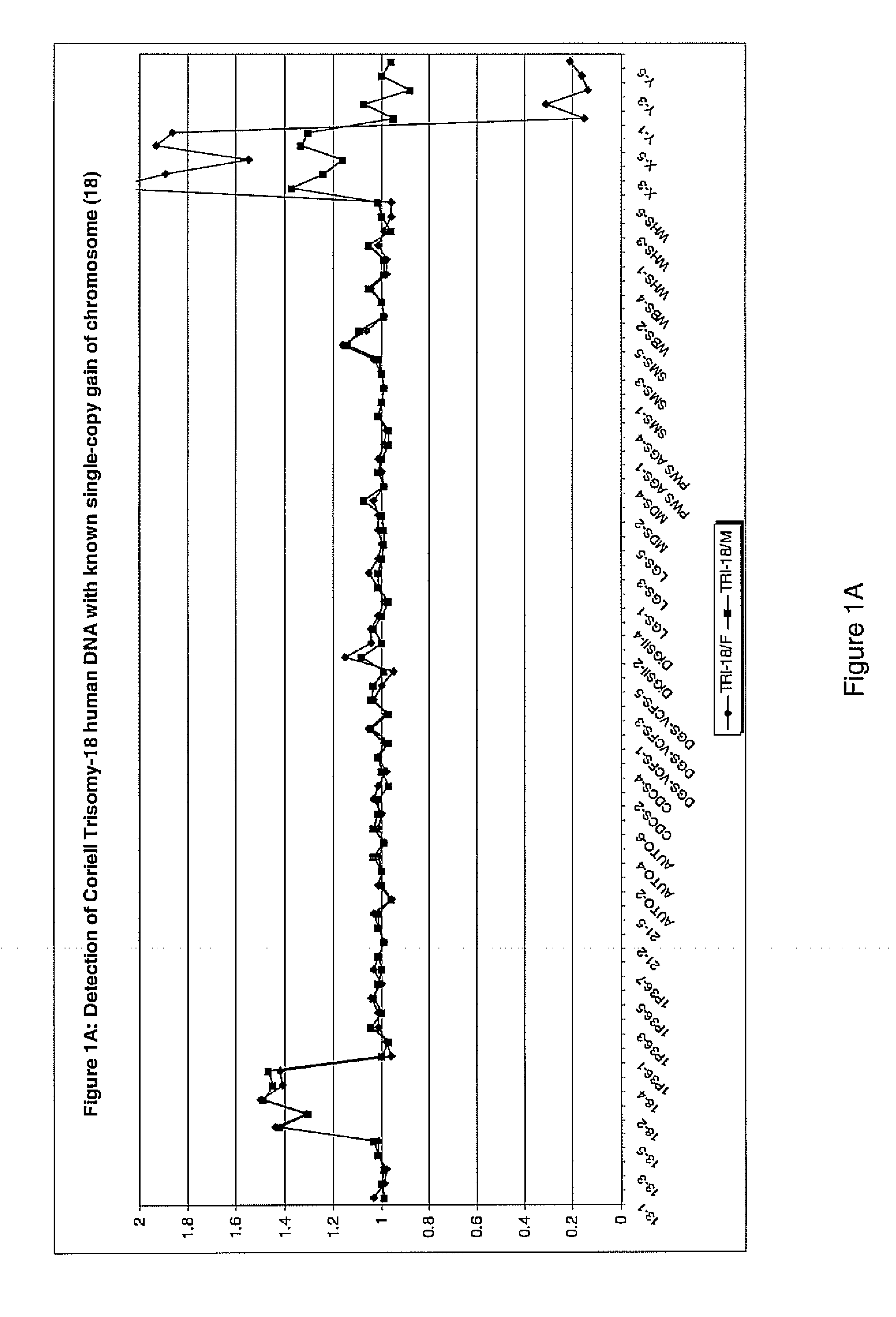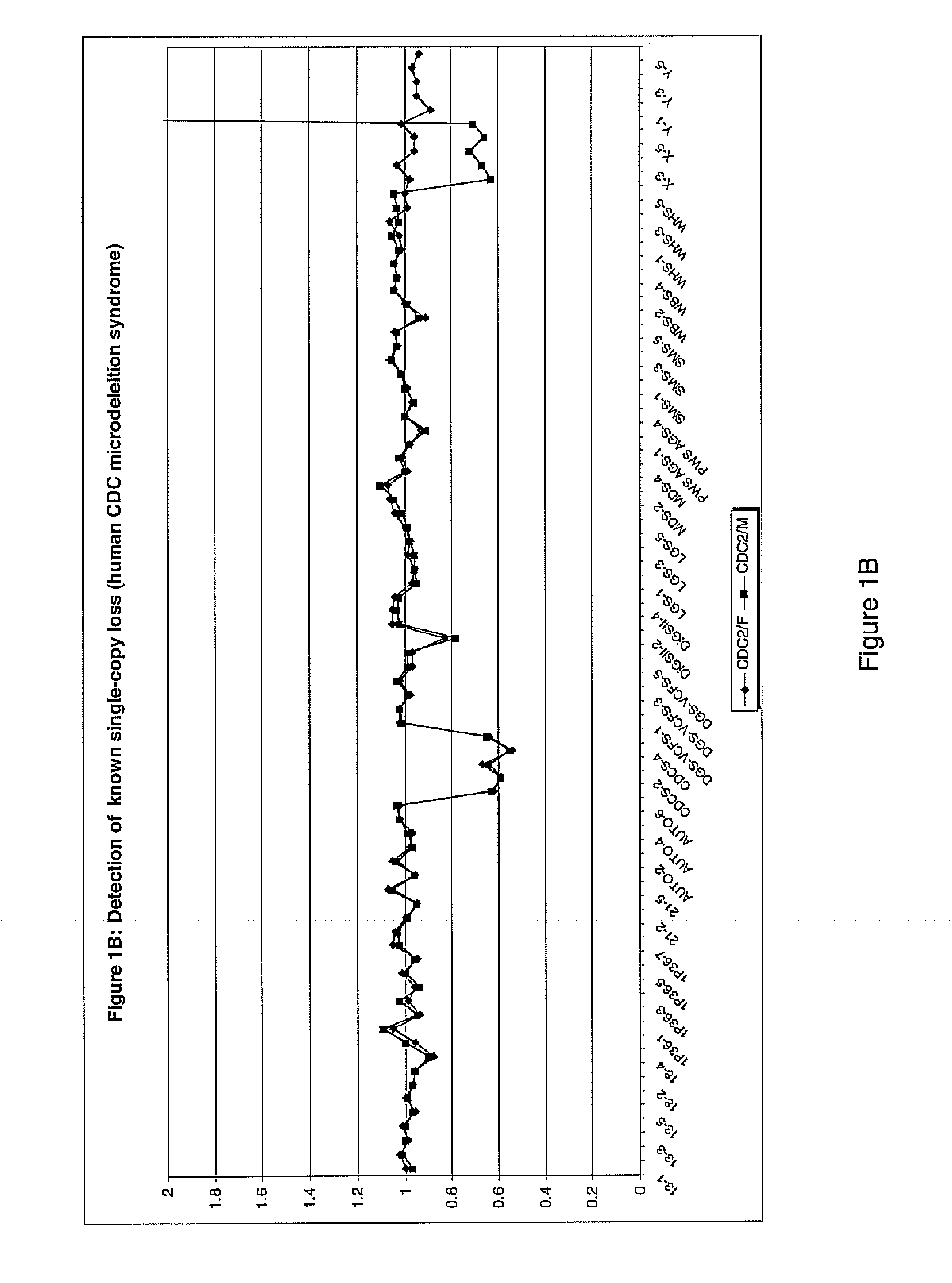Genomic DNA labeling and amplification
a technology of genomic dna and labeling, applied in the field of generating copies of template genomic dna, can solve the problems of difficult quantitative assays, such as genomic copy number analysis, and limited amount of genetic material available for such analytic procedures
- Summary
- Abstract
- Description
- Claims
- Application Information
AI Technical Summary
Benefits of technology
Problems solved by technology
Method used
Image
Examples
example 1
[0056]Isolation of Genomic DNA Template
[0057]Genomic DNA can be isolated by any commercial DNA purification kit from various suppliers, preferably Qiagen kit. Optionally, cells or specimens for use as a source of genomic DNA template are suspended in a buffer containing ribonuclease A. The cells are lysed by standard alkaline lysis techniques followed by centrifugation of the lysate at about 20,000 g for 30 minutes. The supernatant, containing the genomic DNA, is collected. The genomic DNA is extracted and purified from the supernatant by ethanol precipitation and centrifugation. The genomic DNA is resuspended in water or Tris-EDTA buffer.
example 2
[0058]Amplification of Genomic DNA Template
[0059]Test genomic DNA samples and reference DNA samples can be at a concentration of about 0.1 ng / microliter-50 ng / microliter. Twenty-four microliters of test and reference DNA is aliquoted into separate reaction microfuge tubes along with 20 microliters of random sequence oligonucleotide primer mix containing 1400 micrograms / ml random octamers, 125 mM Tris, 12.5 mM MgCl2, and 25 mM 2-mercaptoethanol. Five microliters of a 10× dNTP mix containing: 1.2 mM each DATP, dGTP, dCTP and dTTP, 10 mM Tris 8.0, 1 mM EDTA, is added to each tube. An aliquot of exo-Klenow DNA polymerase containing 10-50 units, is added to each tube. The total volume of each tube is brought to a total of fifty microliters with water if necessary. The tubes containing the reaction mixture are then sealed and incubated at 37° C. for 1-2 hours. Amplified genomic DNA is quantified by measuring absorbance at 260 nm to determine the “fold” amplification.
example 3
[0060]Simultaneous Labeling and Amplification of Genomic DNA Template
[0061]Test genomic DNA samples and reference DNA samples can be about 0.1 ng / microliter-50 ng / microliter. Twenty-four microliters of test and reference DNA is aliquoted into separate reaction microfuge tubes along with 20 microliters of random sequence oligonucleotide primer mix containing 1400 micrograms / ml random octamers, 125 mM Tris, 12.5 mM MgCl2, and 25 mM 2-mercaptoethanol. Optionally, the mixture can then be heated to 95-98 degrees C. and then allowed to cool to 4 degrees C. Five microliters of a 10× DNTP mix containing: 1.2 mM each of dATP, dGTP, and dTTP, 0.6 mM dCTP; 0.6 mM biotin-dCTP; 10 mM Tris 8.0; and 1 mM EDTA, is added to each tube. An aliquot of exo-Klenow DNA polymerase containing 10-50 units, is added to each tube. The total volume of each tube is brought to a total of fifty microliters with water if necessary. The tubes containing the reaction mixture are then sealed and incubated at 37° C. fo...
PUM
| Property | Measurement | Unit |
|---|---|---|
| total volume | aaaaa | aaaaa |
| volume | aaaaa | aaaaa |
| volume | aaaaa | aaaaa |
Abstract
Description
Claims
Application Information
 Login to View More
Login to View More - R&D
- Intellectual Property
- Life Sciences
- Materials
- Tech Scout
- Unparalleled Data Quality
- Higher Quality Content
- 60% Fewer Hallucinations
Browse by: Latest US Patents, China's latest patents, Technical Efficacy Thesaurus, Application Domain, Technology Topic, Popular Technical Reports.
© 2025 PatSnap. All rights reserved.Legal|Privacy policy|Modern Slavery Act Transparency Statement|Sitemap|About US| Contact US: help@patsnap.com


